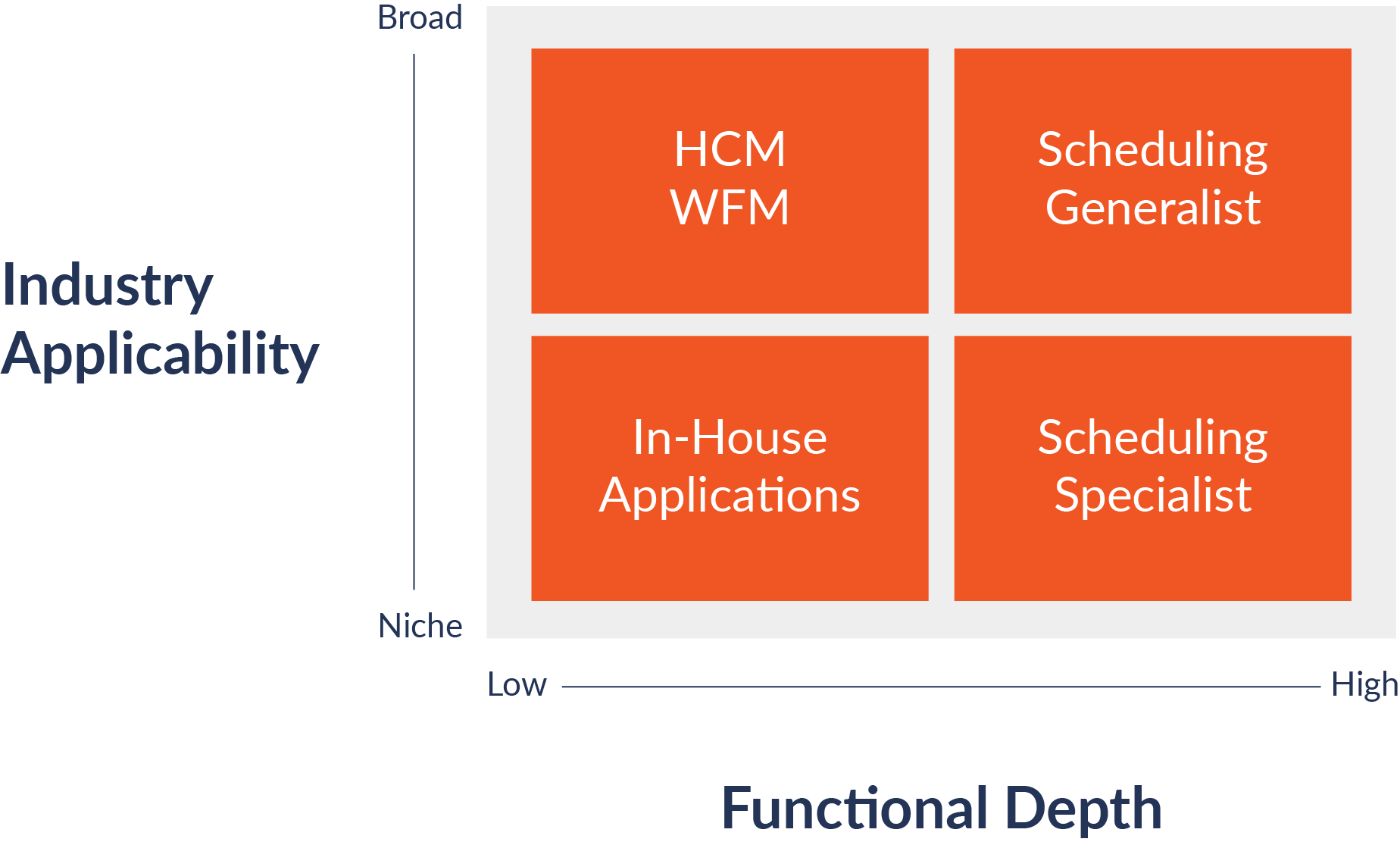Navigating HCM, Specialists, Generalists, and In-House Solutions for Employee Scheduling

As enterprise operations face increasingly complex dynamics in workforce management, the demand for effective employee scheduling technology has grown significantly. The marketplace now offers a wide range of solutions, from basic tools to highly specialized technology. Each solution presents its own set of advantages and drawbacks, making the selection process a daunting task.
In this article, we’ll explore the nuances between different categories of employee scheduling software. By understanding these distinctions, you can better determine which type aligns with your specific needs—whether you’re aiming to optimize labor costs, ensure compliance with regulations, or simply make your day-to-day workforce scheduling operations more efficient.
Understanding the Employee Scheduling Software Landscape
Employee scheduling solutions can be categorized based on two dimensions: industry applicability and scheduling functionality depth. Industry applicability refers to a solution’s specialization in addressing specific industry use cases and processes. Scheduling functionality depth relates to the solution’s ability to effectively address specific employee scheduling challenges, offering advanced features and customizations for optimized employee scheduling processes.

Reference: Gartner Market Guide for Workforce Management Applications 2023
1. Human Capital Management (HCM) and Workforce Management (WFM) Systems
These platforms include vendors like Workday, Dayforce, and ADP. While these systems may offer scheduling modules, these platforms are primarily designed to address broader human resource needs such as time and attendance, payroll, and talent management.
Pros:
- Comprehensive functionality: Offers a wide range of features for various HR functions, including scheduling, payroll, benefits administration, and talent management.
- Seamless integration: Suites are typically designed to facilitate seamless communication between different modules, ensuring data consistency and streamlining administrative tasks.
- Consolidation of HR tech vendors: By opting for an HCM solution, organizations simplify vendor management.
Cons:
- Light-weight scheduling functionality: May not be able to address all scheduling-related goals and challenges comprehensively.
- Limited R&D: It can take months before critical scheduling features are considered for development.
- Customizations are often limited or costly: Customers may be required to adjust their processes to accommodate the limitations of the software. These limitations can result in low user adoption and reliance on Excel and additional process as workarounds, ultimately leading to inefficiencies.
2. Scheduling Generalist
Tools such as When I Work, TCP, Humanity, and Sling are suitable for basic, straightforward scheduling environments void of industry-specific or specialized scheduling capabilities, such as those required by union agreements or fatigue risk management systems.
Pros:
- Wide applicability: Provide essential scheduling functionality, catering to customers with standard processes and simple requirements.
- Quick implementation: Tools with low functionality depth are designed for simplicity, allowing for rapid implementation and ease of adoption by users due to their straightforward nature.
- Cost effective: As they typically offer basic scheduling functionalities, these tools are often more affordable for small and medium-sized businesses with limited budgets.
Cons:
- Limited capability: Often lack advanced features such as coverage optimization, demand forecasting, or integration with other business systems, limiting their ability to address complex scheduling challenges.
- Lack scalability: Typically designed for small and medium-sized businesses and may struggle to scale effectively for enterprises organizations.
- Reduced efficiency: Due to their limited functionality, these tools do not provide the same level of efficiency and optimization in workforce scheduling, leading to inefficiencies and increased administrative burden over time.
3. Scheduling Specialist
Specialists like Shiftboard, Indeavor, and Shyft deliver solutions finely tuned for industry-specific scheduling demands. Their targeted functionalities and sophisticated HCM integration yield superior labor cost control, coverage effectiveness, and compliance with labor and fatigue rules, all while supporting worker-friendly scheduling. Generic tools typically lack this level of integration and tailored customization.
Pros:
- Industry-specific expertise and purpose-built functionality: Deliver out-of-the box capabilities tailored to optimize coverage, reduce labor costs, ensure compliance, and create worker-friendly schedules that match specific industry needs.
- Rich configuration and customization: Offer extensive options for configuration and customization, allowing them to be tailored to match customers’ existing workflows and rules. This flexibility leads to higher efficiency and improved user adoption rates.
- Dedicated R&D: These vendors continuously innovate to stay ahead of market trends. This fosters cross-pollination of best practices in targeted industries, empowering customers to adopt leading-edge scheduling strategies and maintain competitiveness.
- Seamless Integration: These often include robust integration capability for seamless connectivity with customers’ existing tech ecosystems. In doing so, they can leverage these platforms more effectively, transforming rich HCM data into actionable insights that bolster operational efficiency and enhance strategic decision-making across the organization.
Cons:
- Lack comprehensive HR management features: May lack comprehensive HR management features offered by all-in-one solutions, requiring additional systems or processes to cover other HR function.
- Higher cost: Specialized scheduling tools may come at a higher price point compared to generic or all-in-one solutions, potentially posing budgetary constraints for small to medium sized organizations.
- Overkill features: Advanced features might not be necessary for customers with very simple scheduling needs.
4. In-House Applications
These are developed and maintained by a company’s in-house IT teams. These applications are usually built from scratch and customized to the company’s specifications, processes, and workflows.
Pros:
- Tailor made: Fully customized to meet specific business needs, workflows, and requirements for your organization.
- Control: Organizations have full control over the development, implementation, and maintenance timeline.
- Budget friendly: Avoids ongoing licensing fees associated with third-party software, eliminating the need for budget approval processes that can delay development and deployment
Cons:
- Development time: Building custom applications from scratch can be time-consuming, delaying the availability of the solution for immediate use.
- Resource intensive: Developing and maintaining in-house applications demands dedicated resources with specialized skills and deep scheduling domain knowledge, which can be costly and resource intensive.
- Limited scalability: Lack the scalability and flexibility offered by commercial off-the-shelf solutions that are continuously updated and supported by vendors.
- Maintenance and support: Internal teams are responsible for ongoing maintenance, updates, data security, and troubleshooting, which can divert resources from core business activities.
- Risk of dependency: May create a dependency on internal resources, posing challenges if key personnel leave the organization or if specialized skills are required for maintenance and upgrades.
Finding the Right Fit
With a plethora of options to choose from, here are some general guidelines and guardrails to help you streamline your choices.
|
Types of Employee Scheduling Solutions |
Ideal For |
|---|---|
|
HCM and WFM |
|
|
Scheduling Generalist |
|
|
Scheduling Specialist |
|
|
In-House Application |
|
Conclusion
Choosing the right employee scheduling software requires careful consideration of your organization’s specific needs and workflows. Certain industries, such as those in the manufacturing and energy sectors, benefit from specialized technologies like Shiftboard because they are designed to address unique operational demands. When integrated with a robust HCM system such as UKG Pro Workforce Management or Dayforce, specialized employee scheduling technology can maximize the strengths of both platforms, offering a competitive edge over more generalized scheduling software options. Not sure which type is right for you? Connect with our experts for a personalized consultation to discover the perfect fit.

